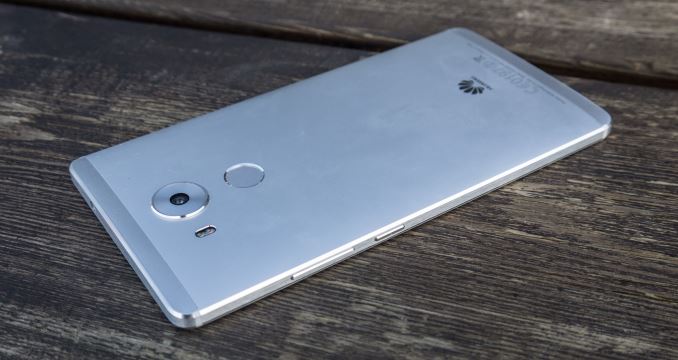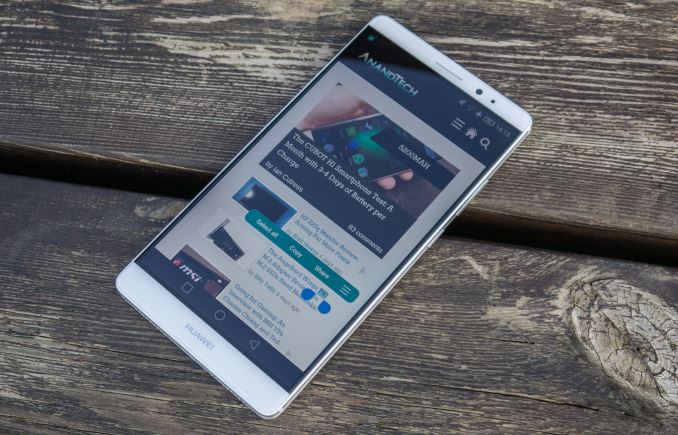The Huawei Mate 8 Review
by Andrei Frumusanu on January 5, 2016 1:00 PM EST- Posted in
- Mobile
- Smartphones
- Huawei
- Cortex A72
- Kirin 950
- Mate 8
- CES 2016
Conclusion & End Remarks
As we come to the end of the review I’m rather pleased with what Huawei was able to do with the Mate 8. Design-wise this is still very clearly a Mate device and fully embraces the form-factor and industrial design established by the Mate 7. This is clearly a large phone as the 6” screen is of the biggest on the market, and certainly one of the only devices of its size competing in the very high-end segment.
The small improvements that the Mate 8 design did bring were all beneficial. The move of the speakers to the bottom enables the phone to have better sound output, and we also saw improvement in build quality as the plastic top and bottom side-panels of the Mate 7 were replaced with aluminium ones. Although not sure if this affects other colour variants, I found the finish of the Mate 8 to be quite of a double-edged sword as while it offers very good grip for a metal phone it also is prone to collect smudges and due to the coarse anodization being hard to clean.
The screen of the Mate 8 has seen the least improvements over the Mate 7 as we’re still seeing usage of a JDI IPS-Neo 1080p panel with the same DDIC as last year’s model. It actually seems that this year’s display shows lower luminance efficiency which can slightly impact battery life. Display calibration has only seen slight improvements, although Huawei fixed the green tint that was present on the Mate 7, the Mate 8 still shows a calibration that favours a large colour gamut that exhibits more vivid and saturated colours.
Huawei continues to embrace dual-SIM capability in all of its phones and the Mate 8 is able to take advantage of this as well – although you have to sacrifice the microSD slot for the second nanoSIM. Coming in 32, 64 and 128GB variants with expandable storage the Mate 8 should offer plenty of space for even most avid power users.
Having discussed the Kirin 950 with HiSilicon during the November launch, I had sort of high expectations of the SoC as on paper it was able to show a lot of promise. Fast-forward to today and not only did the chipset fulfil the expectations and all of its promises, but it actually managed to exceed them as I hadn’t imagined that HiSilicon would be able to reduce CPU power consumption this much. This bodes well not only for the Kirin 950, but for what I hope is an indication of what other vendors with A72 silicon will be able to show. I’m now eagerly looking forward to testing the Snapdragon 820’s Kryo and Samsung’s Exynos 8890’s M1 to see if the two new CPU architectures will be able to match or beat the Cortex A72 implementation in the Kirin 950, as HiSilicon now sets the new bar in terms of power efficiency.
Performance of the Mate 8 was also extremely good. This was not only due to the 2.3GHz A72 CPU cores but also to what seems to be targeted software optimizations and improvements to Android. The Mate 8 is currently the fastest Android device on the market and should be able to perform very well against the upcoming generation of flagships.
On the GPU and 3D performance side Huawei and HiSilicon were able to show very large improvements compared to last year’s models. The new Mali T880MP4 at 900MHz enabled the Huawei device to showcase much needed performance boost. Although we saw large improvements, it’s unlikely that the Mate 8 will be able to compete against upcoming devices with new generation SoCs as the smaller Mali configuration of the Kirin 950 sacrifices power efficiency in favour of die size and thus when looking at overall power efficiency at the same TDP levels, the Mate 8 currently falls behind the competition. Nevertheless I applaud HiSilicon for balancing out the GPU in such a way that thermal throttling is not an issue, thus enabling the Mate 8 to be able to always operate at near its maximum performance, something we can’t say of many of today’s devices.

Through the efficient SoC and the large battery the Mate 8 is able to sport one of the best battery performances among today’s smartphones. It seems that the device is actually being held back by high RF power consumption, something especially visible in the LTE web browsing test where Mate 8 only narrowly manages to outperform the Nexus 6P. This skews usage patterns in favour of high CPU loads as that’s where the Mate 8’s strength lies, vastly outperforming the competition in terms of efficiency.
Still speaking of connectivity, Huawei has finally managed to equip one of its own devices with a competitive WiFi solution that is able to check all the feature boxes such as the much needed 5GHz band and 802.11ac compatibility. Performance is also good although we noticed some odd behaviour in the upstream bandwidth in the 5GHz band.
Lastly, there’s the Mate 8’s camera. In its current state with the B116 firmware version that the device was reviewed on the only way to accurately describe it is as a complete disaster. Huawei has promised that we’ll be seeing a software update in the near future that will be able to correct the problem – so until then we’ll hold out on a definitive conclusion. The Mate 8 did show promise in low-light photography so once and if the focus issue is alleviated and the camera sensor will be able to perform at its full potential, it should in theory be able to compete well against other flagships. Check back in the future as we’ll be updating the review for a complete camera evaluation.
As we arrive to the conclusion, I’m left relatively happy with the Mate 8. Over the last year since I reviewed the Honor 6 and Mate 7 I’ve seen Huawei being able to steadily identify and improve on its weaknesses. In terms of performance and power efficiency the Kirin 950 is able to mark an absolutely enormous jump over last year’s devices as we finally see a proper successor to 2014’s Kirin 920/925. Huawei has said that they’ve been able to gain a lot of software experience while working with Google on the Nexus 6P and it really shows in EmotionUI 4.0, as it showcases exemplary performance.
While this is definitely not a perfect device and Huawei can definitely improve in aspects such as screen quality, I’m tending towards calling the Mate 8 a worthwhile purchase – that is, if Huawei manages to fix the severe camera issues. Until we can revisit that aspect of the device and if the camera is a critical factor in one's purchasing decision of the phone, I’d recommend waiting out on the full evaluation before making a final decision.











116 Comments
View All Comments
syxbit - Tuesday, January 5, 2016 - link
Despite only using the MP4 variant of the Mali-T880, I wish Google had used this SoC in the Nexus 6P.The Snapdragon 810 is garbage, and the only bad thing about my phone. It gets very warm when simply browsing webpages.....
jjj - Tuesday, January 5, 2016 - link
Page 2 you do 810vs 820 FP comparison, wrong paste.tuxRoller - Tuesday, January 5, 2016 - link
Unless your browsing includes js/webgl heavy games, out benchmarks something is wrong with your phone.The only time I've noticed my gf's n6p getting noticeably warm was during benchmarks.
IanHagen - Wednesday, January 6, 2016 - link
Is your girlfriend using her phone outdoors in Winnipeg, by chance?tuxRoller - Wednesday, January 6, 2016 - link
Oymyakon. Why do you ask? Do you think that's significant?IanHagen - Thursday, January 7, 2016 - link
Well tell her to be careful! The ground might be slippery with all this ice and fish laying around, she might slip and drop her brand new phone. That would be a problem. Erm... what was it we were talking about again?tuxRoller - Tuesday, January 12, 2016 - link
Oh, don't worry! The fish aren't a problem any longer. It's really the roving superpacks of wolves you need to watch out for...also, her phone has a case:)Ethos Evoss - Wednesday, January 6, 2016 - link
Ppl never learn that ShtDragon is epic fail..Now SD 820 is going to be tested on LeTV on purpose in case of ignite..
LeTV not realising qualcom used them as experiment and others manufs. will be watching.. bcos nobody wants to implement SD anymore..
syxbit - Wednesday, January 6, 2016 - link
SD800 and SD801 were brilliant chips, and SD805 was pretty good, but came out when others were further along with 64-bit. People have hope that SD820 will bring them back on track. However, if SD820 is bad, QCOM will risk losing permanent trust with everyone. They really have to nail SD820. Even Google was rumoured to be so unhappy with QCOM after SD810 that they began looking into designing their own SoC designs.SD810 was so horrifically bad, that they really owe everyone an apology. SD810 singlehandedly caused most flagship 2015 devices to suck, overheat, and have bad battery life. Worse still, QCOM denied the problems, claiming that people were just just spreading FUD about overheating SD810.
Just look at QCOM's stock. They're at almost half their value from a year ago. All attributable to SD810. They need to apologize, and admit that SD810 was awful before people will believe their claims for SD820.
However, most people believe that QCOM's custom SoC were great, so there's hope for SD820.
extide - Thursday, January 7, 2016 - link
Well, the benches for the 820 are out ... and they look pretty good so I am pretty confident that the 820 will not be a disappointment.